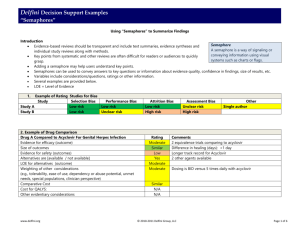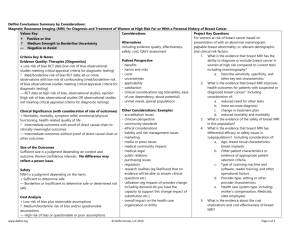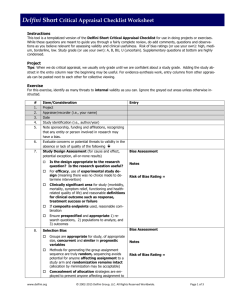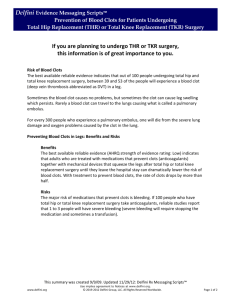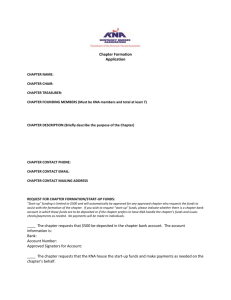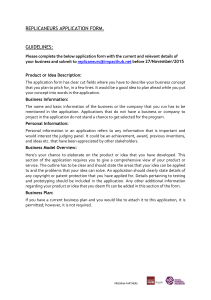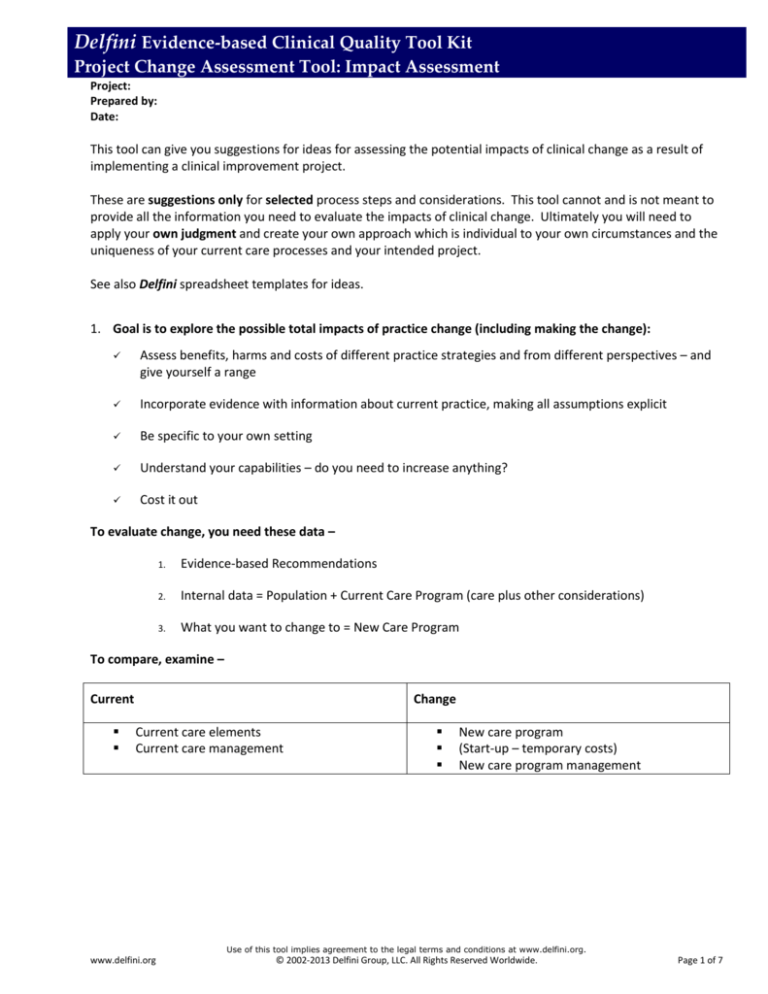
Delfini Evidence-based Clinical Quality Tool Kit
Project Change Assessment Tool: Impact Assessment
Project:
Prepared by:
Date:
This tool can give you suggestions for ideas for assessing the potential impacts of clinical change as a result of
implementing a clinical improvement project.
These are suggestions only for selected process steps and considerations. This tool cannot and is not meant to
provide all the information you need to evaluate the impacts of clinical change. Ultimately you will need to
apply your own judgment and create your own approach which is individual to your own circumstances and the
uniqueness of your current care processes and your intended project.
See also Delfini spreadsheet templates for ideas.
1. Goal is to explore the possible total impacts of practice change (including making the change):
Assess benefits, harms and costs of different practice strategies and from different perspectives – and
give yourself a range
Incorporate evidence with information about current practice, making all assumptions explicit
Be specific to your own setting
Understand your capabilities – do you need to increase anything?
Cost it out
To evaluate change, you need these data –
1.
Evidence-based Recommendations
2.
Internal data = Population + Current Care Program (care plus other considerations)
3.
What you want to change to = New Care Program
To compare, examine –
Current
Change
Current care elements
Current care management
New care program
(Start-up – temporary costs)
New care program management
Use of this tool implies agreement to the legal terms and conditions at www.delfini.org.
www.delfini.org
© 2002-2013 Delfini Group, LLC. All Rights Reserved Worldwide.
Page 1 of 7
Delfini Evidence-based Clinical Quality Tool Kit
Project Change Assessment Tool: Impact Assessment
Project:
Prepared by:
Date:
Instructions: Worksheet for Preparing Narrative Notes on
Anticipated Impacts of Practice Change
This work sheet can help you prepare your cost and change assessment, as well as prepare your measurement plan.
1. Prepare a description of current care processes for the topic of interest. Quantify as much as possible. This
can be in document or spreadsheet form. Use the chart below for ideas about items to cover.
2. For each category write a narrative description of anticipated change (e.g., increase, decrease,
discontinuation, improvement, key notes). Be mindful of areas where you may be decreasing utilization, but
won’t truly experience a net decrease because of no change in staffing.
3. At a minimum, you will want to measure whether your intended change has happened. To do so, you must
measure something you know will have changed if your implementation was successful. Seek measurement
items that are easily doable. For performance measurement, you may wish to refer to Delfini performance
measurement tools.
4. Prepare quantitative estimates of the total population that may be affected over what time period,
considering such factors as prevalence and any exclusions.
Example – Hypothetical Project “Venous Leg Ulcers”
EXAMPLE PAGE
Category
List Current State or Elements; then
Anticipated Change
Recommend for
Measurement?
Utilization Considerations: Systems,
utilization & administrative impacts:
consider → facilities, systems, roles
(including staffing), methods (including
procedures), equipment, supplies,
other resources
Staffing changes – net increase since will
need trainer, but won’t reduce staff
despite visit reduction.
Physical therapy visits – decrease.
Whirlpool therapy – discontinued….etc.
PT visits
Cost (organization, provider and
patient)
High cost area – anticipate decrease in
costs to organization.
Vascular surgery referrals
Health status (symptom relief, quality
of life, survival, function)
Currently care not evidence-based –
anticipate major improvement.
Duration of therapy
Satisfaction: patient and clinical staff
High patient satisfaction with whirlpool
therapy – expect some dissatisfaction
with change.
Use of this tool implies agreement to the legal terms and conditions at www.delfini.org.
www.delfini.org
© 2002-2013 Delfini Group, LLC. All Rights Reserved Worldwide.
Page 2 of 7
Delfini Evidence-based Clinical Quality Tool Kit
Project Change Assessment Tool: Impact Assessment
Project:
Prepared by:
Date:
Worksheet for Preparing Narrative Notes on Anticipated Impacts of Practice Change
List Current State or Elements; then
Anticipated Change
Category
Recommend for
Measurement?
Utilization Considerations: Systems,
utilization & administrative impacts:
consider → facilities, systems, roles
(including staffing), methods (including
procedures), equipment, supplies,
other resources
Cost (organization, provider and
patient)
Health status (symptom relief, quality
of life, survival, function)
Patient impacts (benefits, harms, costs,
risks, uncertainties, alternatives)
Satisfaction: patient and clinical staff
Other – might include such things as
other triangulation issues (e.g.,
regulatory issues, public relations,
medical community impacts, marketing
issues, medical-legal issues, issues of
purchasers, liability and risk
management, cost, community
standards, accreditors, press, overall
impact on the health care organization,
etc.)
Population — Prepare quantitative
estimates of the total population that
may be affected per what time period,
considering such factors as prevalence
and any exclusions.
For additional information as needed:
Use of this tool implies agreement to the legal terms and conditions at www.delfini.org.
www.delfini.org
© 2002-2013 Delfini Group, LLC. All Rights Reserved Worldwide.
Page 3 of 7
Delfini Evidence-based Clinical Quality Tool Kit
Project Change Assessment Tool: Impact Assessment
Project:
Prepared by:
Date:
Instructions: Worksheet for Computing “New Program Cost Assessment”
Goal is to compare costs of your current program of care to your potential new program of care, and consider the
impact of start-up costs for the new program. Definitions in brief (more detailed information is below):
a) = current annual care costs
b) = start-up costs for new program
c) = new program management costs
d) = new care program costs
Step 1. Costs of what you are doing now
EXAMPLE PAGE
a = Annual costs of current care
Care costs = $50,000
Management/admin costs = currently not a managed program, so none unique to area
Notes:
$ 50,000
Step 2. If you implement a change or new project, costs of your start-up period
b+d = Start-up + Annual costs of new care program
b. Start-up period costs (e.g., tool creation, program implementation and start-up period
management) $ 20,000
d. Annual costs of new care program (care only and NOT including b) start-up or c)
program management/administration $ 40,000
Notes:
$ 60,000
Step 3. If you implement this change or new project, costs of your future regular new program
after start-up period
c+d = New program management costs + Annual costs of new care program
c. Post-start-up annual costs of program management (e.g., costs to administer project,
special on-going training, annual dissemination of materials, etc) $ 10,000
d. Annual costs new care program only – from d. above $ 40,000
Notes:
$ 50,000
Step 4. Assessment: Recommend to implement new program since care will improve and
there is no change in costs following $10,000 for implementation.
Compare results
Worksheet for Computing “New Program Cost Assessment”
Use of this tool implies agreement to the legal terms and conditions at www.delfini.org.
www.delfini.org
© 2002-2013 Delfini Group, LLC. All Rights Reserved Worldwide.
Page 4 of 7
Delfini Evidence-based Clinical Quality Tool Kit
Project Change Assessment Tool: Impact Assessment
Project:
Prepared by:
Date:
Goal is to compare costs of your current program of care to your potential new program of care, and consider the
impact of start-up costs for the new program. Definitions in brief (more detailed information is below):
a) = current annual care costs
b) = start-up costs for new program
c) = new program management costs
d) = new care program costs
Step 1. Costs of what you are doing now
a = Annual costs of current care
Care costs =
Management/admin costs =
Notes:
$
Step 2. If you implement a change or new project, costs of your start-up period
b+d = Start-up + Annual costs of new care program
b. Start-up period costs (e.g., tool creation, program implementation and start-up period
management)
d. Annual costs of new care program (care only and NOT including b) start-up or c)
program management/administration
Notes:
$
Step 3. If you implement this change or new project, costs of your future regular new program
after start-up period
c+d = New program management costs + Annual costs of new care program
c. Post-start-up annual costs of program management (e.g., costs to administer project,
special on-going training, annual dissemination of materials, etc)
d. Annual costs new care program only – from d. above
Notes:
$
Step 4. Assessment:
Compare results
Use of this tool implies agreement to the legal terms and conditions at www.delfini.org.
www.delfini.org
© 2002-2013 Delfini Group, LLC. All Rights Reserved Worldwide.
Page 5 of 7
Delfini Evidence-based Clinical Quality Tool Kit
Project Change Assessment Tool: Impact Assessment
Project:
Prepared by:
Date:
Instructions: Worksheet for Computing Incremental Cost Effectiveness
Goal is to be able to compare the marginal or incremental benefit costs of your current program of care (current
state) compared to your potential new program of care (new state).
Before you start, determine if you should do a cost effectiveness analysis (CEA) or not by seeing which quadrant
applies to your project:
Cost
Decreased Effectiveness &
Increased Cost
Do not do CEA (this IS NOT
cost effective)
Effectiveness
Increased Effectiveness &
Increased Cost
Consider doing CEA
Fail the project!!!
Decreased Effectiveness &
Decreased Cost
Consider doing CEA
Increased Effectiveness &
Decreased Cost
Do not do CEA (this IS cost effective)
Pass project to next steps!!!
Simplified Method for Incremental CEA
EXAMPLE PAGE
Step 1. Cost Effectiveness Quadrant: Decreased Effectiveness & Decreased Cost
Step 2. Identify outcome of benefit to compare, and quantify by time period (e.g., number of lives saved, avoided hip
fractures, increased new cases of disease, etc. in what time period)
Outcome of comparison: Hip fractures avoided
Time period: Annually
Quantification of outcome for current care processes: 9.58 avoided fractures
Quantification of outcome for new program: 5.56 avoided fractures
Differential outcome from which program (new or current) 4.02 more avoided fractures with current program
Step 3. Costs of current care processes
$ 2,500,000
Step 4. Costs of new program
$ 2,250,000
Step 5. Difference in program costs
$ 250,000
Step 6. Divide program cost difference by differential outcome
Differential program costs $ 250,000
/ Differential outcome 4.02
= Your cost is $ 62,198
per incremental outcome
Step 7. Other potential cost consequences of change: If we go with the new program, we can anticipate roughly four
more hip fractures a year, which does not take into account the care for those additional hip fractures.
Step 8. Assessment: Stay with current program.
Worksheet for Computing Incremental Cost Effectiveness
Use of this tool implies agreement to the legal terms and conditions at www.delfini.org.
www.delfini.org
© 2002-2013 Delfini Group, LLC. All Rights Reserved Worldwide.
Page 6 of 7
Delfini Evidence-based Clinical Quality Tool Kit
Project Change Assessment Tool: Impact Assessment
Project:
Prepared by:
Date:
Goal is to be able to compare the marginal or incremental benefit costs of your current program of care (current
state) compared to your potential new program of care (new state).
Before you start, determine if you should do a cost effectiveness analysis (CEA) or not by seeing which quadrant
applies to your project:
Cost
Decreased Effectiveness &
Increased Cost
Do not do CEA (this IS NOT
cost effective)
Effectiveness
Increased Effectiveness &
Increased Cost
Consider doing CEA
Fail the project!!!
Decreased Effectiveness &
Decreased Cost
Consider doing CEA
Increased Effectiveness &
Decreased Cost
Do not do CEA (this IS cost effective)
Pass project to next steps!!!
Simplified Method for Incremental CEA
Step 1. Cost Effectiveness Quadrant:
Step 2. Identify outcome of benefit to compare, and quantify by time period (e.g., number of lives saved, avoided hip
fractures, increased new cases of disease, etc. in what time period)
Outcome of comparison:
Time period:
Quantification of outcome for current care processes:
Quantification of outcome for new program:
Differential outcome from which program (new or current)
Step 3. Costs of current care processes
$
Step 4. Costs of new program
$
Step 5. Difference in program costs
$
Step 6. Divide program cost difference by differential outcome
Differential program costs $
/ Differential outcome
= Your cost is $
per incremental outcome
Step 7. Other potential cost consequences of change:
Step 8. Assessment:
Use of this tool implies agreement to the legal terms and conditions at www.delfini.org.
www.delfini.org
© 2002-2013 Delfini Group, LLC. All Rights Reserved Worldwide.
Page 7 of 7

